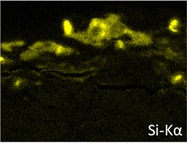Article contents
Adhesion behavior of calcia–magnesia–alumino–silicates on gadolinia-yttria-stabilized zirconia composite thermal barrier coatings
Published online by Cambridge University Press: 03 August 2020
Abstract

Military operations occurring in particle-laden environments have resulted in aircraft incidents and loss of life due to sand ingestion into the engine. Sand melts in the hot combustion environment and deposits as glassy calcia–magnesia–alumino–silicates (CMAS) which leads to rapid performance degradation due to clogged air pathways in the engine. A novel, composite thermal barrier coating (TBC) consisting of yttria-stabilized zirconia (YSZ) blended with gadolinia is proposed that combines the excellent thermo-mechanical properties of YSZ together with the CMAS resistance of rare-earth oxides. YSZ was blended with 2, 8, 17, and 32 vol% gadolinia and tested under simulated engine-relevant conditions. The presence of gadolinia in the composite coating reduced the adhesion of the CMAS, and at 32 vol% gadolinia addition, the CMAS was completely delaminated. A possible CMAS adhesion mitigating mechanism is discussed. This work demonstrated the capability of a new composite TBC to significantly reduce CMAS adhesion.
- Type
- Invited Paper
- Information
- Journal of Materials Research , Volume 35 , Issue 17: Focus Issue: Sand-phobic Thermal/Environmental Barrier Coatings for Gas Turbine Engines , 14 September 2020 , pp. 2335 - 2345
- Copyright
- Copyright © The Author(s), 2020, published on behalf of Materials Research Society by Cambridge University Press
References
- 2
- Cited by




